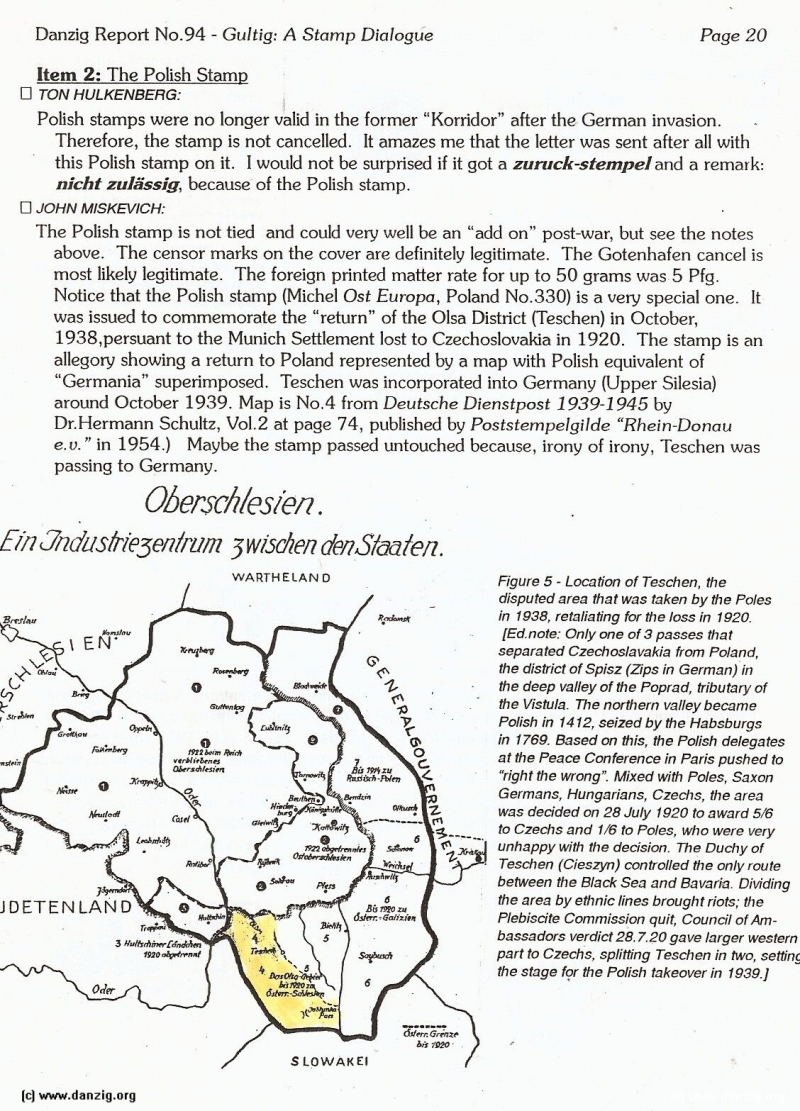
Item 2: The Polish Stamp
TON HULKENBERG:
Polish stamps were no longer valid in the former “Korridor” after the German invasion. Therefore, the stamp is not cancelled. It amazes me that the letter was sent after all with this Polish stamp on it. I would not be surprised if it got a zuruck-stempel and a remark: nichf zulässig, because of the Polish stamp.
JOHN MISKEVICH:
The Polish stamp is not tied and could very well be an “add on” post-war, but see the notes above. The censor marks on the cover are definitely legitimate. The Gotenhafen cancel is most likely legitimate. The foreign printed matter rate for up to 50 grams was 5 Pfg. Notice that the Polish stamp (Michel Ost Europa, Poland No.330) is a very special one. It was issued to commemorate the “return” of the Olsa District (Teschen) in October, 1938,persuant to the Munich Settlement lost to Czechoslovakia in 1920. The stamp is an allegory showing a return to Poland represented by a map with Polish equivalent of “Germania” superimposed. Teschen was incorporated into Germany (Upper Silesia) around October 1939. Map is No.4 from Deutsche Dienstpost 1939-1 945 by Dr.Hermann Schultz, Vol.2 at page 74, published by Poststempelgilde “Rhein-Donau e.v.” in 1954.) Maybe the stamp passed untouched because, irony of irony, Teschen waspassing to Germany.
Figure 5- Location of Tescher, the disputed area that was taken by the Poles in 1938, retaliating for the loss in 1920. fEd.note: Only one of 3 passes that separated Czechoslavakia from Poland, the district of Spisz (Zips in German) in the deep valley of the Poprad, tributary of the Vistula. The northern valley became Polish in 1412, seized by the Habsburgs in 1769. Based on this, the Polish delegates at the Peace Conference in Paris pushed to “right the wrong”. Mixed with Poles, Saxon Germans, Hungarians, Czechs, the area was decided on 28 July 1920 to award 5/6 to Czechs and 1/6 to Poles, who were very unhappy with the decision. The Duchy of Teschen (Cieszyn) controlled the only route between the Black Sea and Bavaria. Dividing the area by ethnic lines brought riots; the Plebiscite Commission quit, Council of Am assadors verdict 28.7.20 gave larger western part to Czechs, splitting Teschen in two, seWn the stage for the Polish takeover in 1939.]
Danzig Report Vol. 1 - Nr. 94 - January - February - March - 1997, Page 20.
Hits: 1526
Added: 19/07/2015
Copyright: 2024 Danzig.org

